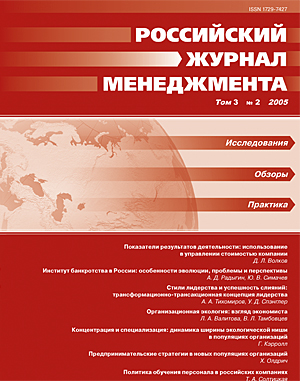Стили лидерства и успешность слияний: трансформационно-трансакционная концепция лидерства
Аннотация
Статья посвящена исследованию зависимостей между стилями лидерства и успешностью корпоративных слияний и поглощений. В первой ее части дан аналитический обзор формирования и развития трансформационно-трансакционной концепции лидерства. Представлены основные поведенческие характеристики трансакционного и трансформационного лидера. Во второй части обсуждаются актуальные вопросы теории и практики корпоративных слияний и поглощений в США. В третьей части стили лидерства рассматриваются в связи с проблемой эффективности и результативности процесса корпоративных слияний и поглощений.
Скачивания
Библиографические ссылки
REFERENCES IN LATIN ALPHABET
Загрузки
Опубликован
Как цитировать
Выпуск
Раздел
Лицензия
Статьи журнала «Российский журнал менеджмента» находятся в открытом доступе и распространяются в соответствии с условиями Лицензионного Договора с Санкт-Петербургским государственным университетом, который бесплатно предоставляет авторам неограниченное распространение и самостоятельное архивирование.





